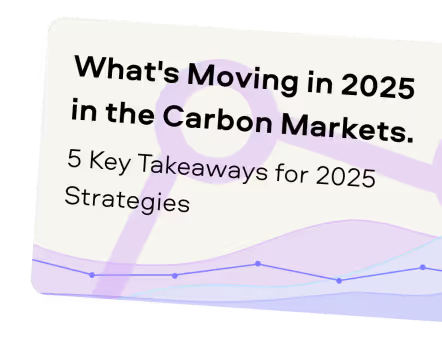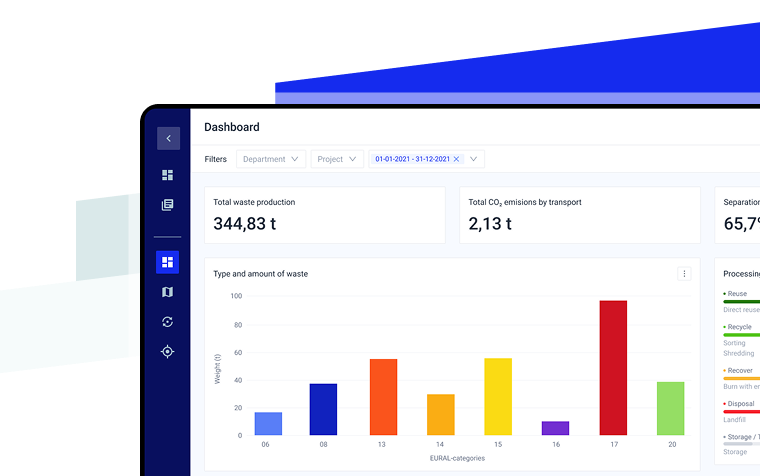“Over the years we’ve invested significantly in our field data team - focusing on producing trusted ratings. While this ensures the accuracy of our Ratings, it doesn’t allow the scale across the thousands of projects that buyers are considering.”
For more information on carbon credit procurement trends, read our "Key Takeaways for 2025" article. We share five, data-backed tips to improve your procurement strategy.

One more thing: Connect to Supply customers also get access to the rest of Sylvera's tools. That means you can easily see project ratings and evaluate an individual project's strengths, procure quality carbon credits, and even monitor project activity (particularly if you’ve invested at the pre-issuance stage.)
Book a free demo of Sylvera to see our platform's procurement and reporting features in action.
Introduction To Waste Management Tools
Managing waste at enterprise scale has become as much a data and technical challenge as a logistical one. Teams preparing reports often find themselves buried in inconsistent spreadsheets and missing manifests. The right apps for waste management or digital waste management tools fixes this by connecting existing systems and suppliers, turning raw waste data into reliable, compliant insights — without disrupting existing workflows.
At the same time, the waste industry is evolving fast. From more innovative recycling technologies to digital platforms that treat waste as a resource, innovation is reshaping the sector. Customers, regulators, and employees now expect businesses not only to manage waste but also to drive circular progress — reusing materials and minimising their environmental impact.
With numerous options on the market — from lightweight waste management apps to comprehensive EHS suites — how do you determine the right fit? This guide highlights the key features that make modern applications for waste management truly enterprise-ready.
What Makes Waste Management Software “Enterprise-Ready”?
Modern software for waste management must do more than track tonnages — it should validate data, ensure auditability, and help enterprises act on insights.
There are several methods for tracking waste, including spreadsheets, processor portals, and comprehensive EHS systems. Most record quantities, but few can prove where the data comes from or how reliable it is. At an enterprise scale, waste management isn’t just about tracking numbers; it’s about ensuring that every figure can withstand audit scrutiny and drive action across the business.
- Standardisation
When every site and vendor reports differently, comparing performance is impossible. Enterprise-grade software automatically consolidates and classifies data from diverse sources into a single, consistent, and reliable dataset — creating a single source of truth across the organisation. - Auditability
Enterprises operate under growing compliance pressure from frameworks such as CSRD, ISO 14001, and national systems like the Dutch E-MJV. To meet these standards, the system must provide full traceability and structured, auditable reporting. The less time your team spends preparing data for inspection or verification, the more time they can spend acting on the results. - Relevance
The most effective systems don’t just centralise data — they build connections across departments and roles. Executives see performance trends and risk exposure, sustainability teams track progress against circularity targets, and operations gain visibility into daily inefficiencies. The less time teams spend translating data, the more time they can spend driving measurable change.
8 Capabilities Every Waste Management Software Needs
Once waste data is standardised, traceable and relevant, it becomes a foundation for real progress. But not all waste management applications can deliver this level of consistency and confidence. The best waste management software combines automation, verification, and analytics to support compliance and sustainability goals. The following capabilities separate basic tracking tools from platforms that actually simplify compliance, enable insight and help teams act on what the data reveals.
1. Automated Data Capture & Global Classification Solutions
Collecting waste data from multiple sites and suppliers is often the most significant barrier to accuracy. A strong application automates this process using document scanning (OCR) and trained AI models that read manifests, invoices and tickets directly. Combined with a global classification system, it standardises information from the start — reducing errors, saving time and ensuring every dataset is reliable and comparable.
2. Traceable Data to Help Manage Waste
Reliable reporting depends on more than numbers — it requires proof. Each data point should link directly to its source document, such as a ticket, invoice or registry record, so every kilogram can be traced back to verified evidence. This transparency makes audits faster, easier and entirely defensible.
3. Automated Audit Trails
Audit readiness isn’t a one-time task; it’s an ongoing record of accountability and responsibility. Built-in audit trails capture who changed what, when and why, creating a transparent history of every update. This not only supports external audits but also strengthens internal quality management processes.
4. Pre-Built Compliance Reporting
Reporting frameworks like CSRD, ISO 14001, and national systems such as the Dutch E-MJV each require structured, auditable formats. Pre-configured templates remove the guesswork by channelling verified data directly into compliant reports. The result: less manual work, fewer errors and consistent reporting across regions and regulations.
5. Continuous Monitoring and Early Warnings
With large and dynamic datasets, accuracy can’t be a once-a-year exercise. Real-time monitoring automatically flags missing documents, anomalies or misclassifications so teams can resolve issues before they become audit findings. This continuous oversight ensures that information remains accurate and audit-ready throughout the year.
6. Analytics and Key Performance Insights for a Sustainable Future
Once waste data is verified, the next step is to understand its meaning. Built-in analytics turn compliance records into actionable insights — from identifying recycling potential to uncovering cost hotspots and inefficiencies. Clear visual overviews and the ability to deep-dive into detail enable teams to address performance gaps, eliminate inefficiencies, and continuously improve operations across the organisation.
7. Benchmarking Across Sites
Seeing the bigger picture helps drive performance. Benchmarking allows teams to compare sites, suppliers and national averages to spot trends, uncover documentation gaps and replicate best practices. When results are measured side by side, improvement becomes measurable and repeatable.
8. Enabling Circular Transformation
The most advanced systems go beyond reporting to drive change. Once data is consistent and auditable, it becomes a catalyst for transformation — shifting from waste management to resource management. By revealing opportunities for reuse, recovery and reduction across the value chain, circular progress starts when trusted data drives real decisions, not just compliance. That can mean anything from optimising container use to redesigning truck collection routes — practical steps that link circular ambitions to real-world operations.
Why Enterprises Need These Capabilities in One Application
Across large organisations, waste data lives in too many places — spreadsheets, processor portals, internal trackers, and regional systems. Not only does this have an impact on security, but each record's activity is in isolation and rarely connects to form a complete picture. The result is data that’s busy, but not necessarily useful. When that happens, even skilled sustainability and QHSE teams face familiar obstacles:
- Inconsistent data: Each site, vendor, and country reports differently, making global alignment almost impossible and comparisons unreliable.
- Limited verification: Validating every data point takes time and expertise. Under pressure, figures are often accepted at face value — even when confidence is low.
- Inefficient workflows: Teams spend hours reconciling files, re-entering numbers and chasing missing documentation instead of analysing results.
- Audit uncertainty: When evidence is scattered across inboxes and systems, compliance checks become slow, stressful and unpredictable.
When organisations consolidate data into one smart waste management app, they eliminate duplication, reduce errors, and ensure every dataset is audit-ready. Automation replaces manual entry, verification ensures accuracy, and audit trails keep every change traceable from the start. Instead of piecing data together, teams can finally focus on what matters — understanding material flows, comparing performance across sites and turning verified information into measurable improvement and circular progress.
How geoFluxus Delivers This Integration
geoFluxus is a digital waste management tool built for enterprise-scale operations. Unlike basic apps for waste management, it integrates deeply with supplier systems and regulatory frameworks.. Where typical ESG or EHS systems stop at tracking, geoFluxus goes further. Every data point is traceable, verifiable and ready for audit. The platform connects directly to your existing vendors and systems, checking incoming data for completeness, consistency and regulatory alignment across all sites, languages and suppliers.
With pre-built templates for CSRD, ISO 14001 and national frameworks such as the Dutch E-MJV, reporting becomes both efficient and dependable. Built-in analytics and benchmarking dashboards highlight cost hotspots, recycling trends and opportunities to improve circularity.
Designed for sustainability, QHSE and procurement teams, geoFluxus provides control and clarity in complex waste networks. It turns compliance from a burden into a strategic advantage.
Example in Practice
A leading agrifood company previously spent several days each month re-entering processor data to prepare internal waste reports. Any deeper analysis required external support, delaying decisions. With geoFluxus, all invoices are now ingested automatically, producing verified reports every month. The system flags missing documents or unusual trends in real time, allowing the team to act quickly, improve processor reliability and recover more materials for reuse.
👉 Discover how geoFluxus transforms fragmented waste data into a single, reliable source of truth, ensuring compliance, insight and measurable circular progress.
Buyer’s Checklist: Features to Look For
Before choosing an app for waste management, decide what truly matters for your organisation. The ideal waste management application should simplify compliance, scale across all sites, and enable verifiable data from day one. Use this checklist to distinguish the must-haves from the nice-to-haves.
✅ Must-haves
- Proven waste expertise – deep understanding of material streams, regulatory frameworks and data structures, ensuring waste-specific accuracy from day one.
- Automated and standardised data capture – OCR and AI that extract and harmonise data from invoices, manifests and processor reports, removing manual work and reducing errors. If you are currently doing this by hand, this done correctly can save your team a lot of time. If you already have systems in place to do this, then look for integrations.
- Traceable, auditable records – every data point linked to its source document, supported by full audit trails and change logs for transparency and accountability.
- Built-in compliance and reporting – pre-configured frameworks for CSRD, ISO 14001 and local systems such as the Dutch E-MJV, turning verified data directly into compliant reports.
- Scalable, insight-driven architecture – one platform for multiple sites, languages and contractors, with analytics and benchmarking to compare performance across the organisation.
- Continuous monitoring and alerts – automatic checks for missing, inconsistent or incomplete data, keeping information accurate and audit-ready all year.
💡 Nice-to-haves
- Minimal operational disruption – integrates with existing processes so teams only change what and when they choose.
- Integrations with invoice systems for extracting information, and with ESG and procurement systems for wider sustainability reporting.
- Industry benchmarks to really know where you stand
- Custom dashboards for internal KPIs and team-specific insights.
- Scenario-planning tools to explore circular or waste-reduction opportunities.
When assessing vendors, prioritise systems that not only collect data but also have the expertise to interpret it. Waste is a highly specialised field that often requires tailored data extraction and classification to ensure accuracy, consistency and compliance.
Conclusion and How To Respond Today
Waste management software must move beyond basic tracking. To meet the scrutiny of EHS reporting, enterprises need systems that ensure accuracy, traceability and scalability across all operations.
If your organisation wants to put a sustainable future first, then the capabilities outlined here are no longer optional. From automated data capture and audit trails to built-in compliance and benchmarking features, these elements are crucial for establishing a unified, accurate source of truth for waste and resource data.
By bringing waste, compliance, and circularity into one unified waste management software platform, geoFluxus helps organisations move from manual reporting to actionable insights—saving time, reducing risk, and enabling measurable sustainability progress.
👉 Book a demo to see how geoFluxus helps leading companies turn fragmented waste data into trusted information that drives compliance and circular value.
FAQs
What is a waste management application?
A waste management application is a digital platform that collects, processes, and reports waste data from across an organisation. Unlike simple trackers, enterprise-grade applications connect multiple vendors and systems to create verified, audit-ready datasets for compliance and performance analysis.
How do waste management apps support CSRD or ISO 14001?
CSRD and ISO 14001 require accurate, traceable environmental data. Waste management software helps meet these standards by automatically capturing waste records, linking them to evidence, and generating compliant reports that auditors can verify — eliminating the need for manual rework and uncertainty.
What’s the difference between tracking apps and audit-ready applications?
Tracking apps record quantities and waste types, but rarely verify the accuracy of their data sources. Audit-ready applications, by contrast, connect every data point to its proof (invoice, manifest, or ticket) and maintain a complete audit trail — ensuring reliability, transparency, and compliance at enterprise scale.
How does geoFluxus compare to basic processor portals?
Processor portals only show what a single vendor reports. geoFluxus consolidates and verifies data from all processors and sites, automatically detecting inconsistencies and missing documentation. The result: one unified, compliant dataset you can trust across your entire organisation.









